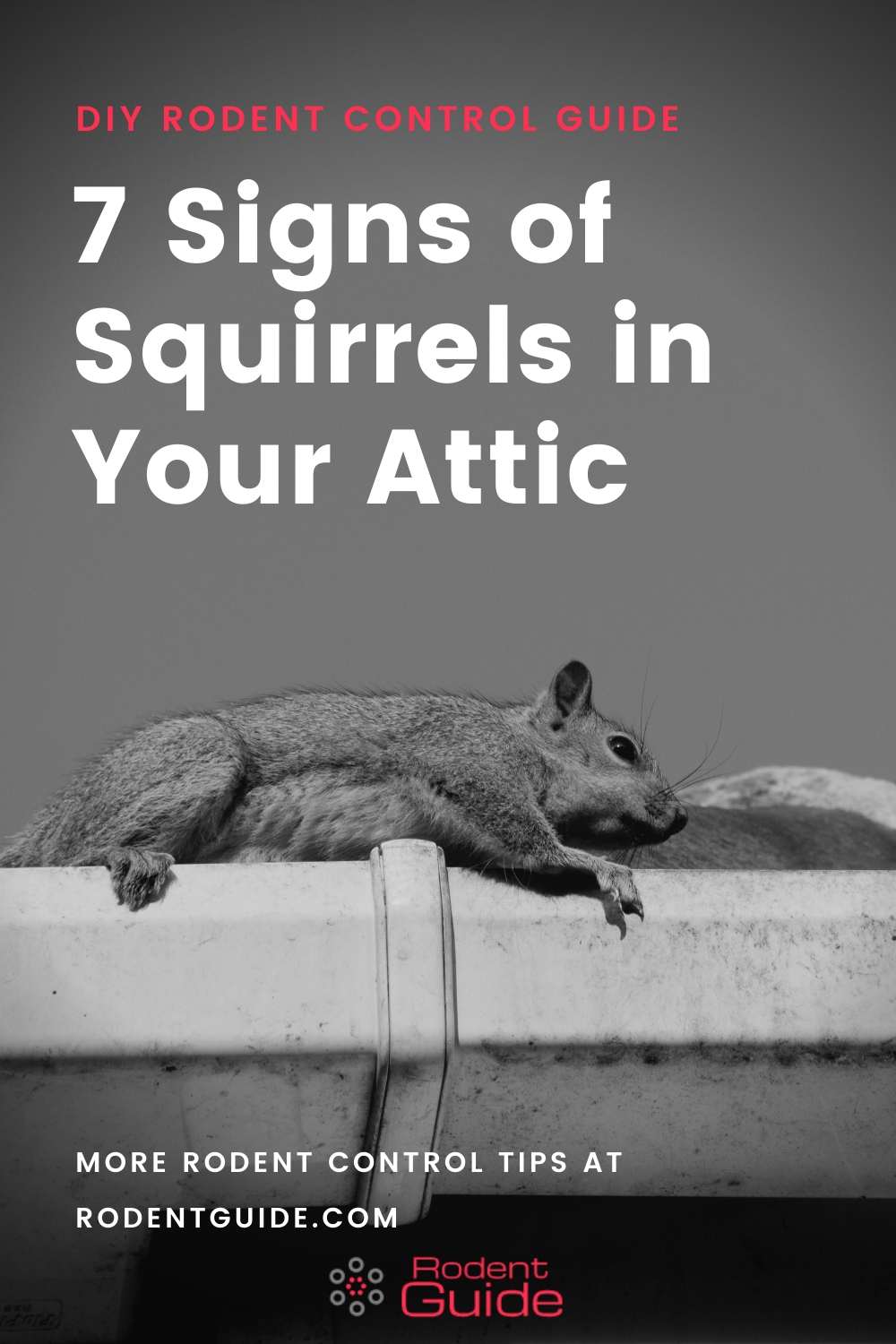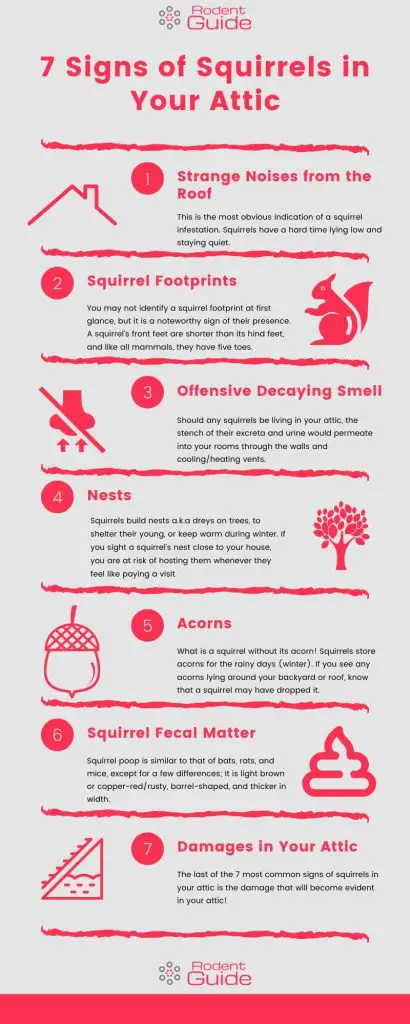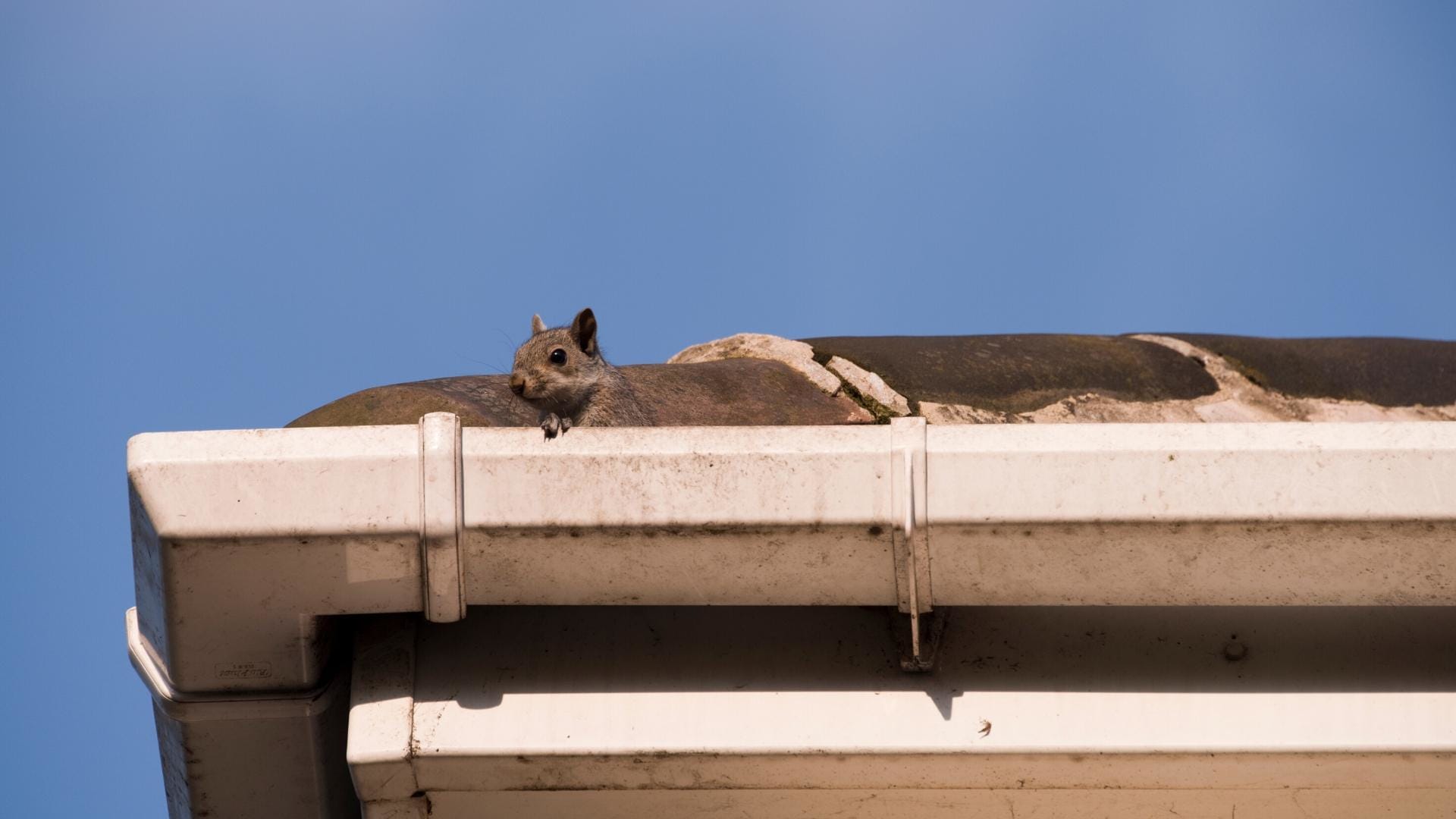These cute, fuzzy-looking rodents are a beauty to observe on Television or even around your neighborhood, but they are not welcome in your home because they can cause serious damage.
Squirrel infestations call for unplanned financial and energy expenditure to get them out and fix damages caused. Statistics hold them responsible for thousands of house fires annually in the United States. This is because, to keep their four front teeth sharp, they gnaw and chew at anything they can lay their paws on – including electric wires.
The longer they stay, the bigger the havoc they’d reek; you can avoid this by reading this post to the end to find out the 7 most common signs of squirrels in your attic. Once you can affirm their presence and uncover their hideouts, it would be easy to take quick action in getting rid of them.
What you will learn in this post:
- Signs of squirrels in your attic
- What damage a squirrel can cause in your attic

7 Signs of Squirrels in Your Attic
Squirrels can break in at any time of the year; during late winter and summer, pregnant female squirrels move into houses to build nests and birth up to 5 kittens. Also, if you happen to witness any squirrel fights or activities around your house, chances are, you’ve got squirrels in your home too.
Squirrels can always devise an entry point into your house because they can chew their way in. They can get in through the roof vents, damaged soffit air vent covers, ventilator fan openings, etc. Whatever route they choose to take in, they’d always end up in your safe, warm attic.
Here are 7 different signs of having squirrels in your attic:

1. Strange Noises from the Roof
This is the most obvious indication of a squirrel infestation. Squirrels have a hard time lying low and staying quiet. During their active hours, early mornings till late afternoon, you would probably hear them scratching, eating, scampering, or tripping over things right above you.
While you are up and working during the day, listen carefully for any noises or odd sounds. Squirrels make some very strange noises! If you hear any of these squirrel noises, and it stops as quickly as it starts. It is probably a squirrel running around the attic.
2. Squirrel Footprints
You may not identify a squirrel footprint at first glance, but it is a noteworthy sign of their presence. A squirrel’s front feet are shorter than its hind feet, and like all mammals, they have five toes. Wherever they leave their tracks in the soil/snow, their claws would always show.
If you notice foot tracks like this around your house, attic, garage, backyard, or garden, along with some other signs mentioned in this post, then you should look to get rid of the squirrels from your attic ASAP.
3. Offensive Decaying Smell
Should any squirrels be living in your attic, the stench of their excreta and urine would permeate into your rooms through the walls and cooling/heating vents. This smell can be very repelling and can stop you from welcoming any visitors.
Do you know what’s even worse? When a squirrel can’t find its way out of your house, it dies and starts decaying. The smell of decaying animals is very fetid; if you have a hard time tracing it, look around your attic. It could be a squirrel! Ensure you are protected before going into your attic if you think it may be a dead rodent.
4. Nests
Squirrels build nests, a.k.a dreys on trees, to shelter their young or keep warm during winter. If you sight a squirrel’s nest close to your house, you are at risk of hosting them whenever they feel like paying a visit. They would bring their nests along with them and get other building materials such as leaves, feathers, twigs, and your housing materials to recreate their home in your attic.
Look out for chipped-off wood and roof insulation, leaves, and foreign objects that may suggest that a squirrel(s) is staying in your attic.
5. Acorns
What is a squirrel without its acorn! Squirrels store acorns for the rainy days (winter). If you see any acorns lying around your backyard or roof, know that a squirrel may have dropped it while hurriedly running to store some in your attic.
This is one of the most commonly missed signs of squirrels in your attic.
Take note of your surroundings and look out for any acorns lying around. If you keep seeing acorns in unusual spots, take a look at your attic! Be careful.
6. Squirrel Fecal Matter
Squirrel poop is similar to that of bats, rats, and mice, except for a few differences; It is light brown or copper-red/rusty, barrel-shaped, and thicker in width. And over time, their feces turns white. Squirrels would usually poop at their entry points or their nesting place.
So, if you notice squirrel droppings around your house, in the attic, garage, or your backyard, you should be on the lookout for any squirrels. And if you are having difficulty recognizing or confirming squirrel droppings, call in a professional to identify and handle the situation. Remember to proper hygiene after coming in contact with their feces as it carries disease-causing bacteria.
7. Damages in Your Attic
The last of the 7 most common signs of squirrels in your attic is the damage that will become evident in your attic!
Squirrels will cause serious damages to your house; they can destroy the exterior and interior of your home. They’d eat up anything they can find, which includes wires, wood, pipes, insulation, etc. They can weaken the structure of your roof and cause your roof to collapse. The longer squirrels stay and multiply, the more prominent the damage will be.
But you don’t have to wait for a huge disaster to happen. You can scrutinize the key corners of your house and look into the attic periodically to check for any chipped wood or remnants or eaten wires.
What Damage can a Squirrel Cause in Your attack?
If you have a squirrel in your attic, the result could be a huge repair bill. Why? Because squirrels have the potential to cause some serious structural damage in your attic.
Squirrels chew on wood, which means they could be chewing the beans in your attic. Over time, these beans will become weaker and weaker. Eventually, the beams may collapse.
Also – you have to consider the other damage that a squirrel can cause in your attic, such as the damage to your sentimental items. Most items in your attic can be repaired or replaced. If a squirrel chews its way through all your old photographs (to make a nest, for instance), then you will not get those back again.
Squirrel urine can soak into wooden beams, causing an odor that is difficult to get out.
If you have noticed signs of squirrels in your attic, then you should look to get rid of them asap!
Conclusion
And that’s it for our list of signs of squirrels in your attic!
If you have noticed squirrels in your attic and you want to address the problem yourself, then I suggest setting up a cage trap in your attic with some tasty squirrel bait.
If you are not comfortable with addressing the squirrel problem yourself, you should seek a professional pest removal service in your local area.
Good luck!


